IDS 402: Analyzing the Impact of Environmental Pollution on Wellness
VerifiedAdded on 2023/04/20
|5
|1192
|326
Report
AI Summary
This report discusses the significant issue of environmental pollution and its profound impact on wellness, particularly focusing on vulnerable populations such as the elderly and those living in poverty. It highlights how environmental factors like climate change and air pollution contribute to increased morbidity and mortality rates, respiratory illnesses, and overall diminished quality of life. The report emphasizes the link between environmental degradation and the disruption of essential resources, leading to financial stress, increased risk of violence, and social instability. The analysis underscores the importance of addressing environmental pollution to safeguard public health and promote overall well-being, referencing research that demonstrates the direct correlation between climate-related changes and adverse health outcomes. This student contributed assignment is available on Desklib, a platform offering a range of study tools and resources for students.
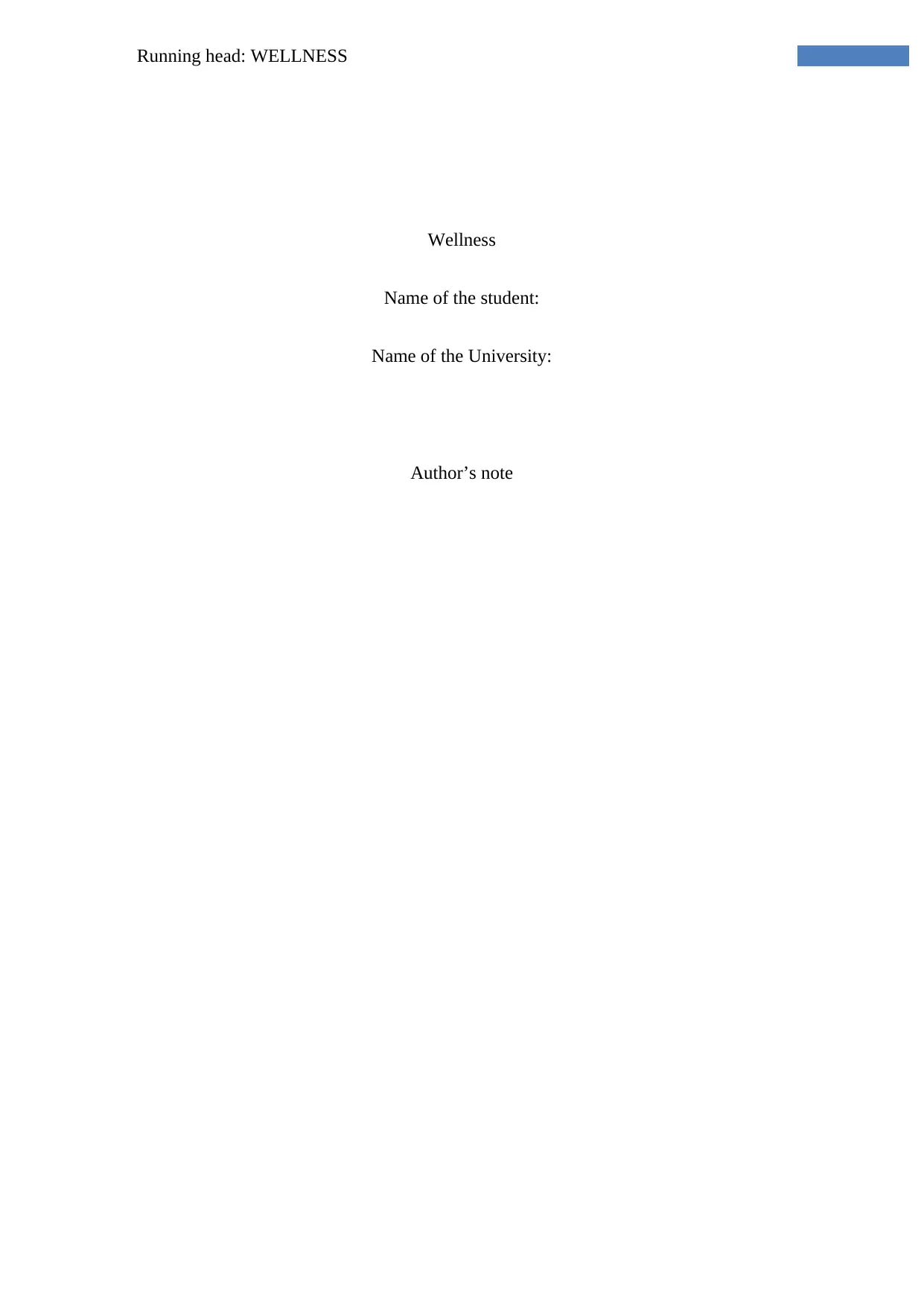
Running head: WELLNESS
Wellness
Name of the student:
Name of the University:
Author’s note
Wellness
Name of the student:
Name of the University:
Author’s note
Paraphrase This Document
Need a fresh take? Get an instant paraphrase of this document with our AI Paraphraser
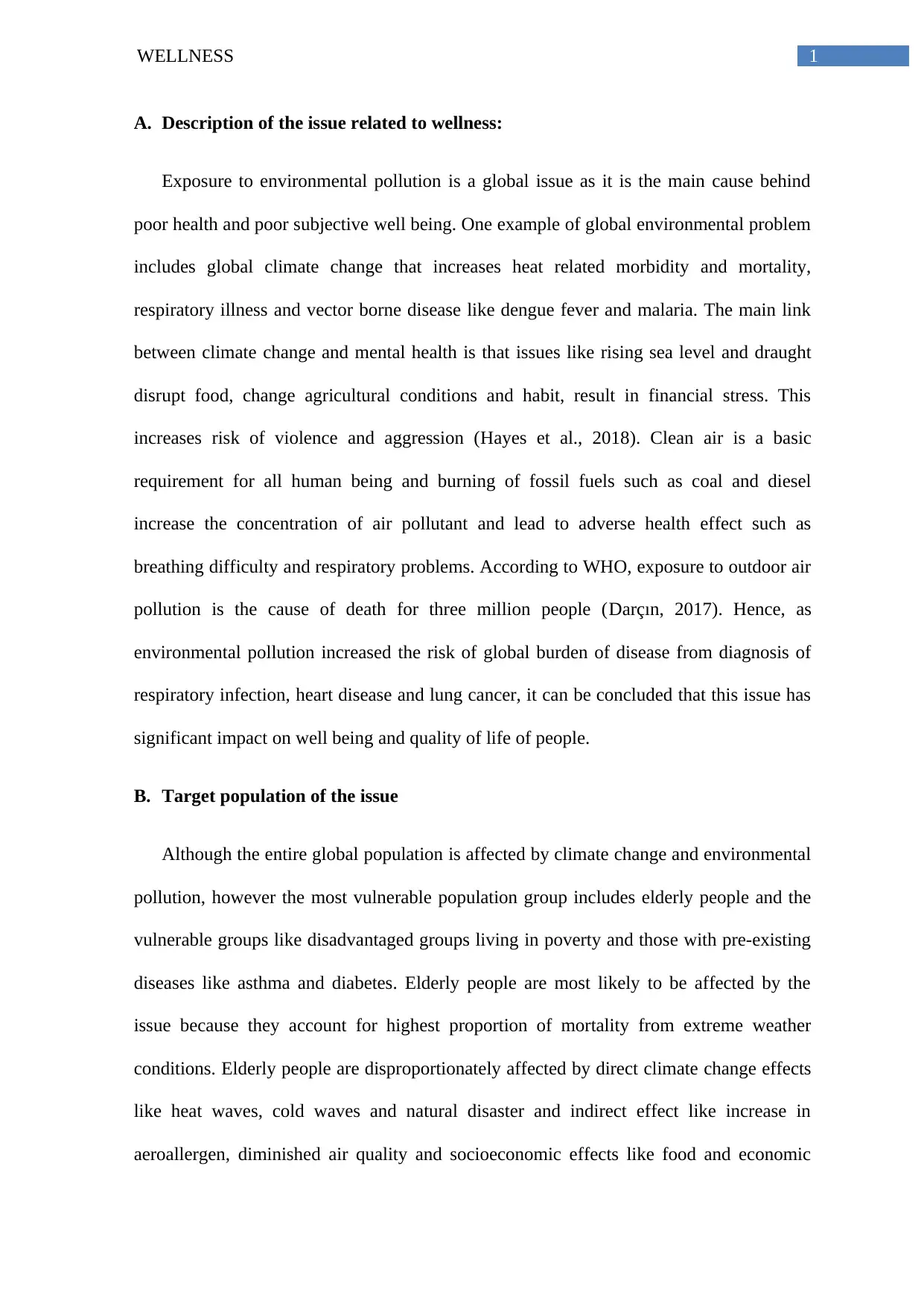
1WELLNESS
A. Description of the issue related to wellness:
Exposure to environmental pollution is a global issue as it is the main cause behind
poor health and poor subjective well being. One example of global environmental problem
includes global climate change that increases heat related morbidity and mortality,
respiratory illness and vector borne disease like dengue fever and malaria. The main link
between climate change and mental health is that issues like rising sea level and draught
disrupt food, change agricultural conditions and habit, result in financial stress. This
increases risk of violence and aggression (Hayes et al., 2018). Clean air is a basic
requirement for all human being and burning of fossil fuels such as coal and diesel
increase the concentration of air pollutant and lead to adverse health effect such as
breathing difficulty and respiratory problems. According to WHO, exposure to outdoor air
pollution is the cause of death for three million people (Darçın, 2017). Hence, as
environmental pollution increased the risk of global burden of disease from diagnosis of
respiratory infection, heart disease and lung cancer, it can be concluded that this issue has
significant impact on well being and quality of life of people.
B. Target population of the issue
Although the entire global population is affected by climate change and environmental
pollution, however the most vulnerable population group includes elderly people and the
vulnerable groups like disadvantaged groups living in poverty and those with pre-existing
diseases like asthma and diabetes. Elderly people are most likely to be affected by the
issue because they account for highest proportion of mortality from extreme weather
conditions. Elderly people are disproportionately affected by direct climate change effects
like heat waves, cold waves and natural disaster and indirect effect like increase in
aeroallergen, diminished air quality and socioeconomic effects like food and economic
A. Description of the issue related to wellness:
Exposure to environmental pollution is a global issue as it is the main cause behind
poor health and poor subjective well being. One example of global environmental problem
includes global climate change that increases heat related morbidity and mortality,
respiratory illness and vector borne disease like dengue fever and malaria. The main link
between climate change and mental health is that issues like rising sea level and draught
disrupt food, change agricultural conditions and habit, result in financial stress. This
increases risk of violence and aggression (Hayes et al., 2018). Clean air is a basic
requirement for all human being and burning of fossil fuels such as coal and diesel
increase the concentration of air pollutant and lead to adverse health effect such as
breathing difficulty and respiratory problems. According to WHO, exposure to outdoor air
pollution is the cause of death for three million people (Darçın, 2017). Hence, as
environmental pollution increased the risk of global burden of disease from diagnosis of
respiratory infection, heart disease and lung cancer, it can be concluded that this issue has
significant impact on well being and quality of life of people.
B. Target population of the issue
Although the entire global population is affected by climate change and environmental
pollution, however the most vulnerable population group includes elderly people and the
vulnerable groups like disadvantaged groups living in poverty and those with pre-existing
diseases like asthma and diabetes. Elderly people are most likely to be affected by the
issue because they account for highest proportion of mortality from extreme weather
conditions. Elderly people are disproportionately affected by direct climate change effects
like heat waves, cold waves and natural disaster and indirect effect like increase in
aeroallergen, diminished air quality and socioeconomic effects like food and economic
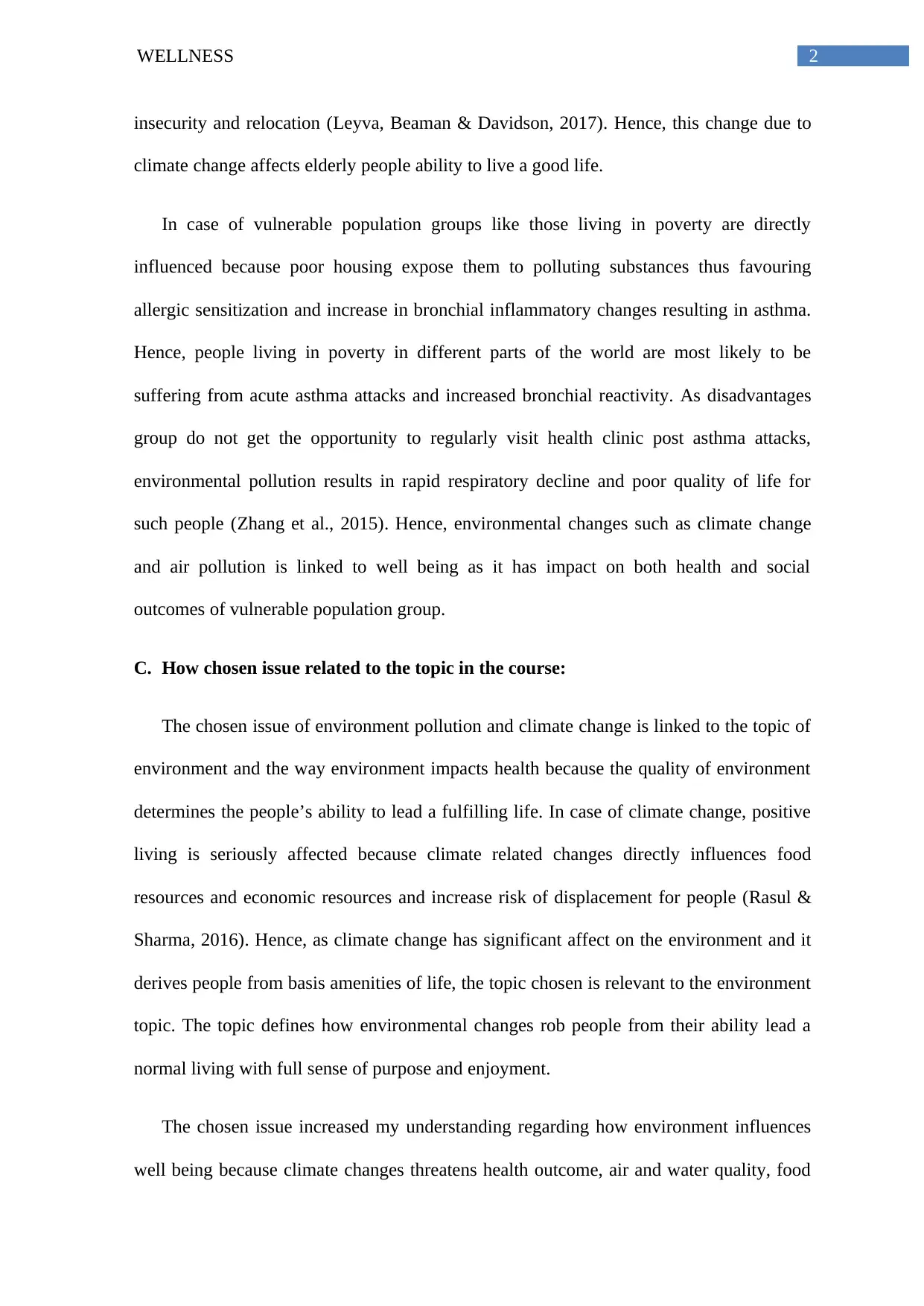
2WELLNESS
insecurity and relocation (Leyva, Beaman & Davidson, 2017). Hence, this change due to
climate change affects elderly people ability to live a good life.
In case of vulnerable population groups like those living in poverty are directly
influenced because poor housing expose them to polluting substances thus favouring
allergic sensitization and increase in bronchial inflammatory changes resulting in asthma.
Hence, people living in poverty in different parts of the world are most likely to be
suffering from acute asthma attacks and increased bronchial reactivity. As disadvantages
group do not get the opportunity to regularly visit health clinic post asthma attacks,
environmental pollution results in rapid respiratory decline and poor quality of life for
such people (Zhang et al., 2015). Hence, environmental changes such as climate change
and air pollution is linked to well being as it has impact on both health and social
outcomes of vulnerable population group.
C. How chosen issue related to the topic in the course:
The chosen issue of environment pollution and climate change is linked to the topic of
environment and the way environment impacts health because the quality of environment
determines the people’s ability to lead a fulfilling life. In case of climate change, positive
living is seriously affected because climate related changes directly influences food
resources and economic resources and increase risk of displacement for people (Rasul &
Sharma, 2016). Hence, as climate change has significant affect on the environment and it
derives people from basis amenities of life, the topic chosen is relevant to the environment
topic. The topic defines how environmental changes rob people from their ability lead a
normal living with full sense of purpose and enjoyment.
The chosen issue increased my understanding regarding how environment influences
well being because climate changes threatens health outcome, air and water quality, food
insecurity and relocation (Leyva, Beaman & Davidson, 2017). Hence, this change due to
climate change affects elderly people ability to live a good life.
In case of vulnerable population groups like those living in poverty are directly
influenced because poor housing expose them to polluting substances thus favouring
allergic sensitization and increase in bronchial inflammatory changes resulting in asthma.
Hence, people living in poverty in different parts of the world are most likely to be
suffering from acute asthma attacks and increased bronchial reactivity. As disadvantages
group do not get the opportunity to regularly visit health clinic post asthma attacks,
environmental pollution results in rapid respiratory decline and poor quality of life for
such people (Zhang et al., 2015). Hence, environmental changes such as climate change
and air pollution is linked to well being as it has impact on both health and social
outcomes of vulnerable population group.
C. How chosen issue related to the topic in the course:
The chosen issue of environment pollution and climate change is linked to the topic of
environment and the way environment impacts health because the quality of environment
determines the people’s ability to lead a fulfilling life. In case of climate change, positive
living is seriously affected because climate related changes directly influences food
resources and economic resources and increase risk of displacement for people (Rasul &
Sharma, 2016). Hence, as climate change has significant affect on the environment and it
derives people from basis amenities of life, the topic chosen is relevant to the environment
topic. The topic defines how environmental changes rob people from their ability lead a
normal living with full sense of purpose and enjoyment.
The chosen issue increased my understanding regarding how environment influences
well being because climate changes threatens health outcome, air and water quality, food
⊘ This is a preview!⊘
Do you want full access?
Subscribe today to unlock all pages.

Trusted by 1+ million students worldwide
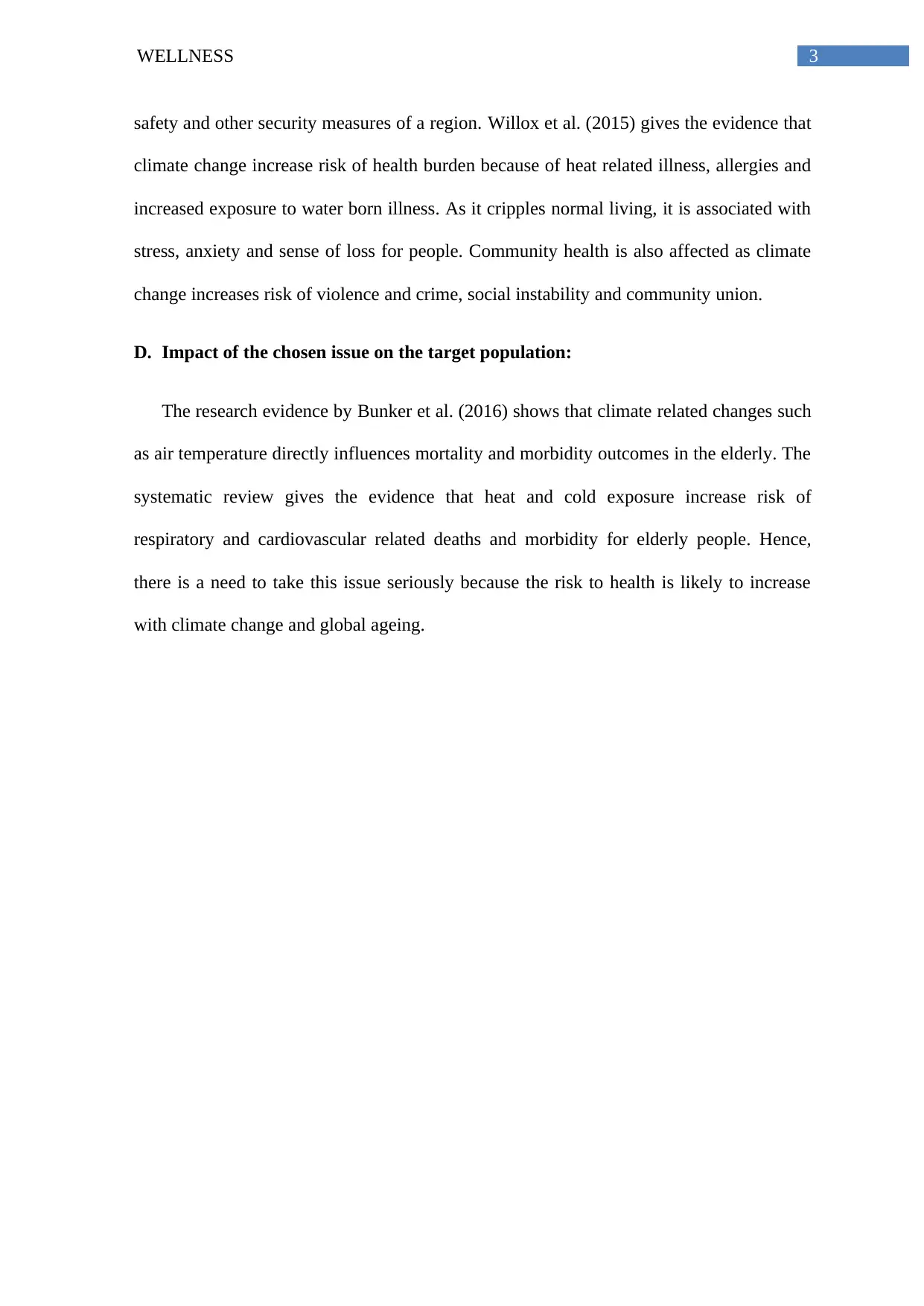
3WELLNESS
safety and other security measures of a region. Willox et al. (2015) gives the evidence that
climate change increase risk of health burden because of heat related illness, allergies and
increased exposure to water born illness. As it cripples normal living, it is associated with
stress, anxiety and sense of loss for people. Community health is also affected as climate
change increases risk of violence and crime, social instability and community union.
D. Impact of the chosen issue on the target population:
The research evidence by Bunker et al. (2016) shows that climate related changes such
as air temperature directly influences mortality and morbidity outcomes in the elderly. The
systematic review gives the evidence that heat and cold exposure increase risk of
respiratory and cardiovascular related deaths and morbidity for elderly people. Hence,
there is a need to take this issue seriously because the risk to health is likely to increase
with climate change and global ageing.
safety and other security measures of a region. Willox et al. (2015) gives the evidence that
climate change increase risk of health burden because of heat related illness, allergies and
increased exposure to water born illness. As it cripples normal living, it is associated with
stress, anxiety and sense of loss for people. Community health is also affected as climate
change increases risk of violence and crime, social instability and community union.
D. Impact of the chosen issue on the target population:
The research evidence by Bunker et al. (2016) shows that climate related changes such
as air temperature directly influences mortality and morbidity outcomes in the elderly. The
systematic review gives the evidence that heat and cold exposure increase risk of
respiratory and cardiovascular related deaths and morbidity for elderly people. Hence,
there is a need to take this issue seriously because the risk to health is likely to increase
with climate change and global ageing.
Paraphrase This Document
Need a fresh take? Get an instant paraphrase of this document with our AI Paraphraser
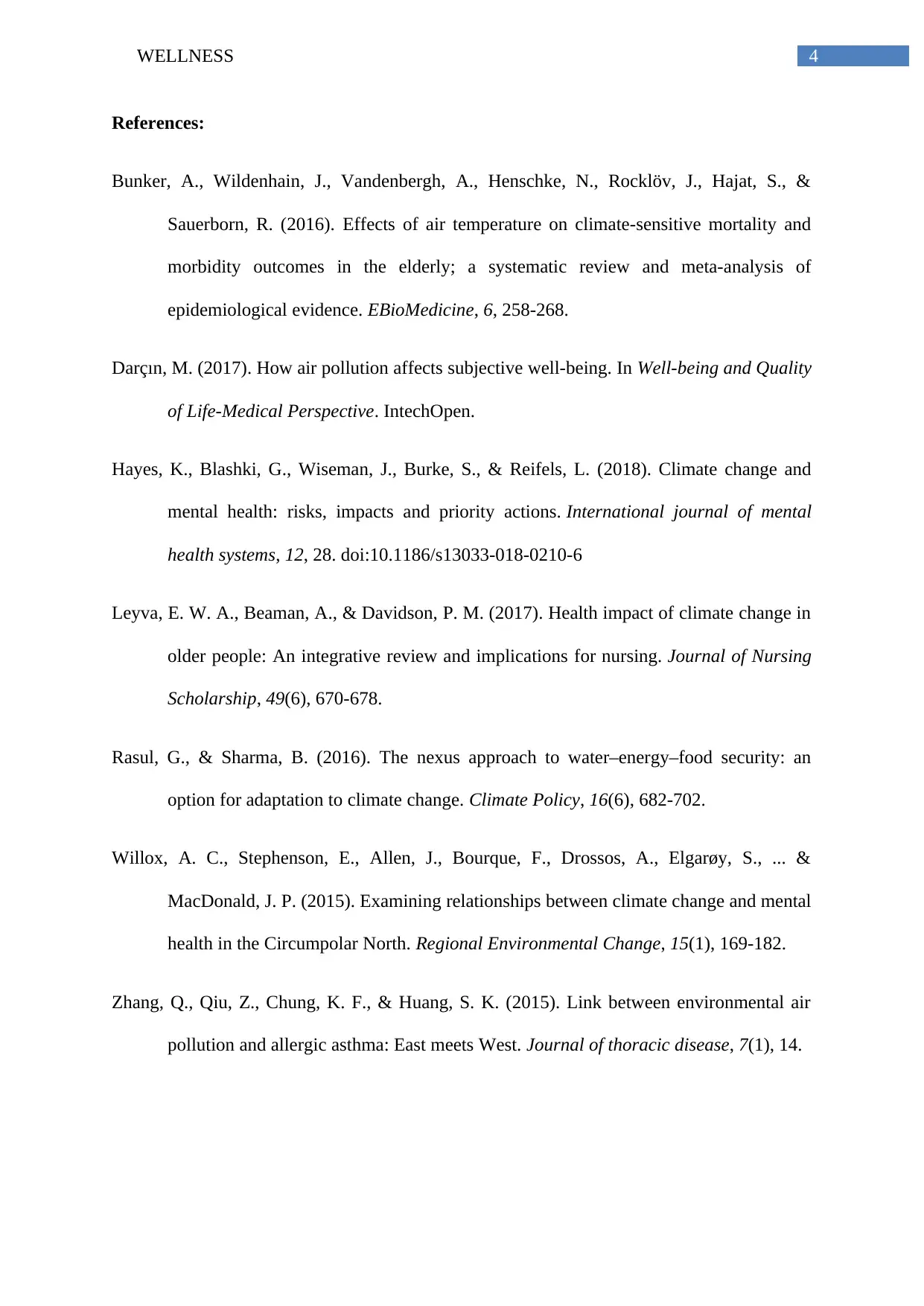
4WELLNESS
References:
Bunker, A., Wildenhain, J., Vandenbergh, A., Henschke, N., Rocklöv, J., Hajat, S., &
Sauerborn, R. (2016). Effects of air temperature on climate-sensitive mortality and
morbidity outcomes in the elderly; a systematic review and meta-analysis of
epidemiological evidence. EBioMedicine, 6, 258-268.
Darçın, M. (2017). How air pollution affects subjective well-being. In Well-being and Quality
of Life-Medical Perspective. IntechOpen.
Hayes, K., Blashki, G., Wiseman, J., Burke, S., & Reifels, L. (2018). Climate change and
mental health: risks, impacts and priority actions. International journal of mental
health systems, 12, 28. doi:10.1186/s13033-018-0210-6
Leyva, E. W. A., Beaman, A., & Davidson, P. M. (2017). Health impact of climate change in
older people: An integrative review and implications for nursing. Journal of Nursing
Scholarship, 49(6), 670-678.
Rasul, G., & Sharma, B. (2016). The nexus approach to water–energy–food security: an
option for adaptation to climate change. Climate Policy, 16(6), 682-702.
Willox, A. C., Stephenson, E., Allen, J., Bourque, F., Drossos, A., Elgarøy, S., ... &
MacDonald, J. P. (2015). Examining relationships between climate change and mental
health in the Circumpolar North. Regional Environmental Change, 15(1), 169-182.
Zhang, Q., Qiu, Z., Chung, K. F., & Huang, S. K. (2015). Link between environmental air
pollution and allergic asthma: East meets West. Journal of thoracic disease, 7(1), 14.
References:
Bunker, A., Wildenhain, J., Vandenbergh, A., Henschke, N., Rocklöv, J., Hajat, S., &
Sauerborn, R. (2016). Effects of air temperature on climate-sensitive mortality and
morbidity outcomes in the elderly; a systematic review and meta-analysis of
epidemiological evidence. EBioMedicine, 6, 258-268.
Darçın, M. (2017). How air pollution affects subjective well-being. In Well-being and Quality
of Life-Medical Perspective. IntechOpen.
Hayes, K., Blashki, G., Wiseman, J., Burke, S., & Reifels, L. (2018). Climate change and
mental health: risks, impacts and priority actions. International journal of mental
health systems, 12, 28. doi:10.1186/s13033-018-0210-6
Leyva, E. W. A., Beaman, A., & Davidson, P. M. (2017). Health impact of climate change in
older people: An integrative review and implications for nursing. Journal of Nursing
Scholarship, 49(6), 670-678.
Rasul, G., & Sharma, B. (2016). The nexus approach to water–energy–food security: an
option for adaptation to climate change. Climate Policy, 16(6), 682-702.
Willox, A. C., Stephenson, E., Allen, J., Bourque, F., Drossos, A., Elgarøy, S., ... &
MacDonald, J. P. (2015). Examining relationships between climate change and mental
health in the Circumpolar North. Regional Environmental Change, 15(1), 169-182.
Zhang, Q., Qiu, Z., Chung, K. F., & Huang, S. K. (2015). Link between environmental air
pollution and allergic asthma: East meets West. Journal of thoracic disease, 7(1), 14.
1 out of 5
Related Documents
Your All-in-One AI-Powered Toolkit for Academic Success.
+13062052269
info@desklib.com
Available 24*7 on WhatsApp / Email
![[object Object]](/_next/static/media/star-bottom.7253800d.svg)
Unlock your academic potential
Copyright © 2020–2025 A2Z Services. All Rights Reserved. Developed and managed by ZUCOL.





